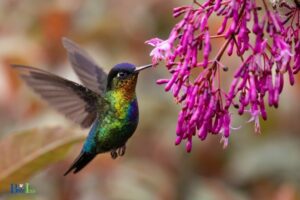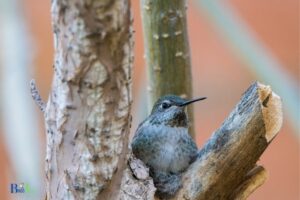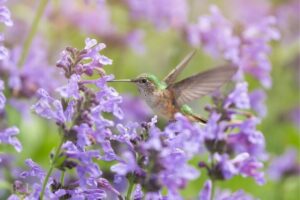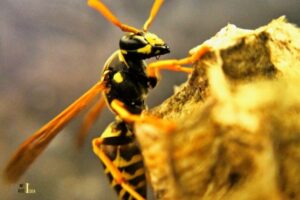When Do Hummingbirds Nest in Ohio? Late April and Early July
Hummingbirds typically nest in Ohio between late April and early July.
Hummingbirds, specifically the Ruby-throated Hummingbird, are migratory birds that travel to Ohio during the warmer months to breed and nest. They arrive in Ohio in late April and begin searching for suitable nesting sites.
The actual nesting period usually occurs between May and early July, with some pairs potentially nesting into August.
Once the breeding and nesting season is over, Ruby-throated Hummingbirds start migrating south towards Central America by late August or early September.
The Ruby-throated Hummingbird is the most common hummingbird species found in Ohio, nesting in deciduous and mixed woodlands. These tiny birds are known for their extraordinary flight abilities and iridescent plumage.
During the nesting period, female hummingbirds build cup-shaped nests made from plant materials, such as lichens and spider webs, on tree branches usually 10-20 feet above the ground.
They lay about two white, pea-sized eggs, which hatch after 12-14 days, leading to a new generation of hummingbirds to populate the region during the summer months.
Nesting Period of Hummingbirds in Ohio
| Month | Hummingbird Nesting Status in Ohio |
|---|---|
| January | Not nesting |
| February | Not nesting |
| March | Not nesting |
| April | Beginning of nesting season |
| May | Nesting |
| June | Nesting |
| July | Nesting |
| August | End of nesting season |
| September | Not nesting |
| October | Not nesting |
| November | Not nesting |
| December | Not nesting |
Key Takeaway
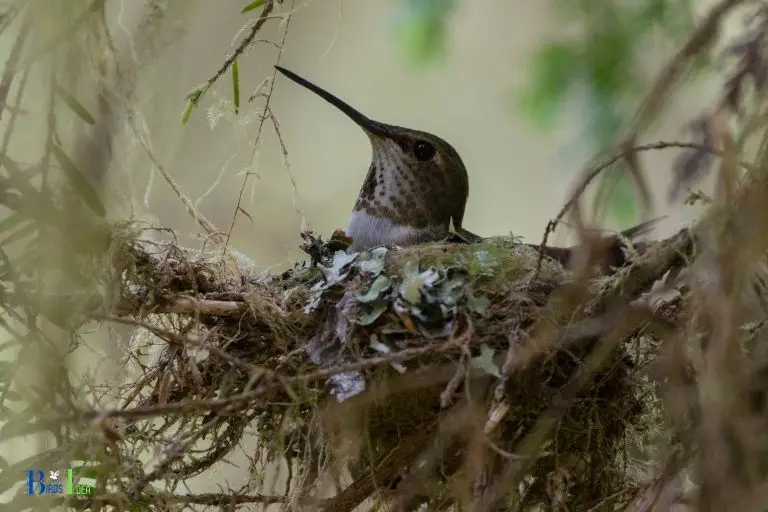
Five Facts About Hummingbird Nesting in Ohio
Understanding The Life Cycle Of A Hummingbird
When Do Hummingbirds Nest In Ohio
Hummingbirds are fascinating creatures and a delight to watch when they buzz about in your yard. It’s a common question – when do hummingbirds nest in ohio? To find the answer, we need to understand the life cycle of a hummingbird.
Overview Of Hummingbirds
Hummingbirds are small, colorful birds that are unique in many ways.
Here are some key facts about them:
- There are over 300 species of hummingbirds in the world, and most of them are found in central and south america.
- The smallest hummingbird is the bee hummingbird, which is only 2.2 inches long.
- Hummingbirds can fly in any direction, including backward, and can hover in place for extended periods of time.
- They have excellent eyesight and can see light in the ultraviolet range, which helps them locate nectar in flowers.
Understanding The Nesting Process
Hummingbirds are migratory birds that spend their winters in warmer climates and return to their breeding grounds in the spring. In ohio, hummingbirds usually arrive in april and start building their nests soon after.
Here are some key points to understand about hummingbird nesting:
- Hummingbirds build cup-shaped nests made of spider webs, plant fibers, and lichen. The nests are about the size of a golf ball and are often built on tree branches or shrubs.
- Hummingbirds typically lay two eggs at a time, which are about the size of small jellybeans. The eggs hatch in about two weeks, and the chicks fledge in another 2-3 weeks.
- Female hummingbirds are responsible for building the nest, incubating the eggs, and feeding the young. Males do not participate in nesting activities.
The Importance Of Timing In Hummingbird Breeding
Timing is critical when it comes to hummingbird breeding. If the birds arrive too early, there may not be enough food available for them.
If they arrive too late, they may not have enough time to nest and raise their young before they need to start their migration south for the winter.
Here are some key points to remember about timing in hummingbird breeding:
- Hummingbirds arrive in ohio in april, and nesting usually starts soon after.
- It’s essential to have hummingbird feeders and flowers with nectar available before the birds arrive so they can find food when they need it.
- Late summer and early fall are also critical times for hummingbirds because they need to build up their fat reserves for their long journey south.
Understanding the life cycle of a hummingbird is fascinating and offers unique insights into these fascinating little creatures.
As ohioans, we have the privilege of being able to observe them up close and follow their journey from their arrival in the spring to their departure in the fall.
With proper timing and preparation, we can help support them on their journey and enjoy their beauty in our own backyards!
Ohio’s Hummingbirds: A Brief Introduction
Hummingbirds are fascinating creatures that can be found all over the world. In ohio, these tiny birds often go unnoticed by many people, but they play a critical role in the local ecosystem.
Hummingbirds are essential pollinators, and they often serve as an indicator of the overall health of an ecosystem.
We will discuss the different types of hummingbirds found in ohio, their migration patterns, and their general habitat information.
Types Of Hummingbirds Found In Ohio
Ohio is home to several types of hummingbirds, including:
- Ruby-throated hummingbirds: These are the most common type of hummingbirds found in ohio. They are named for the ruby-red patch on the throat of the male birds.
- Rufous hummingbirds: These birds are less common in ohio but still make an appearance. They are rusty-orange in color.
- Black-chinned hummingbirds: These birds are rare in ohio, but sightings occur during migration periods. They are named for a faint black stripe on the chin.
Migration Patterns
Ohio is located along a major migratory pathway for hummingbirds. In the spring, hummingbirds migrate from central america, south america, and mexico to breed in the northern parts of the united states and canada. In the fall, they migrate back south to their wintering grounds.
The migration period, therefore, happens twice a year. As many bird watchers already know, hummingbirds are incredibly speedy and can travel up to 25 miles per hour.
General Habitat Information
Hummingbirds are often associated with flowers, and it makes sense. Flowers provide them with nectar, a major component of hummingbirds food intake.
Other habitat requirements include:
- Trees and shrubs for perching and nesting
- Open spaces for foraging
- Plenty of sunlight for warmth
In ohio, hummingbirds can be spotted in gardens, parks, and natural areas. Planting flowers, specifically those that bloom in the summer season, can help attract hummingbirds to your yard.
Ohio is home to several types of hummingbirds, and they play a crucial role in the ecosystem. By providing a habitat for these birds, we can help preserve their population and appreciate their unique beauty.
The Nesting Period For Hummingbirds In Ohio
Ohio is home to several bird species, and as a bird enthusiast, it is fascinating to learn about the nesting periods of different birds.
Hummingbirds, ohio’s smallest bird, are a sight to behold. If you’re curious about the nesting period of hummingbirds in ohio, then you’ve come to the right place.
Determining The Best Time To Observe Hummingbirds Nesting In Ohio
Hummingbirds are migratory birds that usually arrive in ohio from the southern parts of the united states in april. However, the best time to observe hummingbird nesting in ohio is from may to august.
During this period, the birds are busy building their nests, laying eggs, and taking care of their young. If you’re planning to observe hummingbirds nesting in ohio, make sure to visit during this time.
Factors That Affect Nesting Periods, Including Climate And Habitat
Hummingbird nesting periods can vary depending on several factors, including climate and habitat.
Here are some key points to consider:
- Hummingbirds require a suitable habitat to build their nests. A good habitat for hummingbirds includes open spaces with flowers as a food source and protective trees or shrubs to build nests.
- The climate plays an important role in hummingbird nesting behavior. Ohio’s humid continental climate is ideal for hummingbirds as they prefer mild temperatures. They tend to avoid areas with extreme temperatures or weather conditions, which can affect their nesting period.
- Predators, such as snakes and squirrels, can also affect hummingbird nesting behavior. Hummingbirds usually choose elevated areas or trees with dense foliage to minimize the risk of predation.
When To Expect The Arrival Of Hummingbirds
Hummingbirds are migratory birds that arrive in ohio in april and may. Each year, the timing of their arrival may vary slightly depending on local weather patterns. It is essential to keep your eyes peeled around this time to spot these tiny birds.
Hummingbirds stay in ohio for the summer before migrating back to their wintering grounds in the southern united states and central america.
Observing hummingbirds nesting in ohio can be a fascinating experience for any bird enthusiast. Remember, hummingbirds require a suitable habitat to build their nests, and climate can affect their nesting behavior.
To observe hummingbirds nesting, visit ohio from may to august, and keep an eye out for these tiny birds from april onwards.
Nesting Behavior Of Hummingbirds In Ohio
When Do Hummingbirds Nest In Ohio
Ohio is home to eight hummingbird species, including the ruby-throated hummingbird, the only species known to breed in ohio.
Hummingbirds are tiny and delicate birds, but their nesting behavior is quite interesting. We’ll explore when hummingbirds nest in ohio and their nesting behaviors.
Types Of Nests Built By Hummingbirds:
Hummingbirds are known for building intricate and tiny nests for their offspring. The nests are commonly cup-shaped, but the size and shape of the nest depend on the species of hummingbird.
Here are some examples of hummingbird nests:
- Cup-shaped nests may be made of plant fibers, hair, feathers, mosses, and lichens.
- Pendulous nests hang from branches, and they are made of plant fibers and spider silk.
- Platform nests are made of fine plant materials and are attached to branches using spider silk.
Selection Of Nesting Site:
Hummingbirds select nesting sites based on several factors. They prefer nesting sites near food sources, water, and shelter.
Here are the key factors considered by hummingbirds while selecting nesting sites:
- Food sources: Hummingbirds like to nest near flowering plants and bushes, which provide nectar and insects.
- Water sources: Hummingbirds prefer nesting sites near water sources, such as ponds, streams, or fountains. The water can help keep the nesting area cool.
- Shelter: Hummingbirds prefer nesting sites that are protected from the wind, rain, and direct sunlight.
Mating And Reproduction Process:
Hummingbirds have a unique mating and reproduction process.
Here’s what you need to know:
- Male hummingbirds perform courtship aerial displays to attract females.
- Once a female selects a mate, they will perform “dances” in the air.
- Females will build the nests and lay two white eggs about the size of small jellybeans.
- It takes 16-18 days for the eggs to hatch.
- The baby hummers will fledge and fly away from the nests two to three weeks after hatching.
Hummingbirds have a fascinating nesting behavior that includes delicate nests, careful selection of nesting sites, and a unique mating and reproduction process.
If you want to see hummingbirds nesting in ohio, nest-building usually takes place in late april or early may.
FAQ About Hummingbirds Nest In Ohio
When Do Hummingbirds Migrate From Ohio?
How Do I Attract Hummingbirds To Nest In My Ohio Yard?
How Can I Help Protect Hummingbird Nests In Ohio?
How Long Does It Take For Hummingbird Eggs To Hatch In Ohio?
Conclusion
Now that you know when hummingbirds nest in ohio, you can appreciate the beauty and mystery of these tiny birds even more. It’s fascinating to learn about their nesting habits and how they tirelessly care for their young.
We hope this information has inspired you to take a closer look at your own backyard and see if you can spot a hummingbird nest.
Remember to keep a respectful distance and not disturb the nest. By providing a safe and welcoming habitat for hummingbirds, you can help ensure their continued survival for generations to come.
Happy birdwatching!


